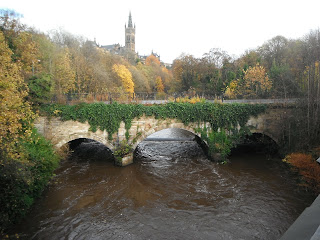If you’re a fan of Charles Rennie Mackintosh, you'll be familiar with the Willow Tea Rooms on Sauchiehall Street, with the distinctive monochrome sign and leaded glass.
Inside is a feast of silver and heather as reflections glitter on the mirrored glass. This is the where the well-to-do women of the time would flock for refreshment after making their careful purchases from the glamorous department stores nearby.Not much has changed. In fact, my husband was the only man in the place when we visited.
Ten minutes’ walk away is George Square itself, with the palatial City Chambers dominating the skyline.
The only crowds now are the schoolchildren doing the free guided tour of the building interior, which is staggering in its opulence (although the youngsters seemed underwhelmed).
Luxurious marble stairways, mosaic floors, gold gilt ceilings and gleaming ceramic doorways ...
No expense was spared. The City Chambers building cost £552,028. Including furnishings, the whole project cost £578,232.
On 6 October, 1883, 600,000 spectators watched a trades march of skilled workers from the city’s heavy industries and a civic-masonic procession converged in George Square for the laying of the foundation stone by the Lord Provost.
The original building covered 5,016 square metres. With extensions, now 14,000 square metres.A total of10 million bricks, 9905 cubic metres of stone and 537.7 cubic metres of granite were used. In 1889, a 10-day public viewing attracted 400,000 people.
Continue your virtual tour past the proud towers of university and the massive monolith of Kelvingrove Art Gallery, and you'll find yourself treading the elegant streets near the botanic gardens, with the distinctive oriental-style domes of the Kibble glasshouses, housing arrays of dark ferns and dazzling orchids.
Beyond, stroll across the bridge, you’ll see graceful townhouses with picturesque views over the rushy waters in an almost quintessential Edwardian scene.
By Pamela Kelt









No comments:
Post a Comment